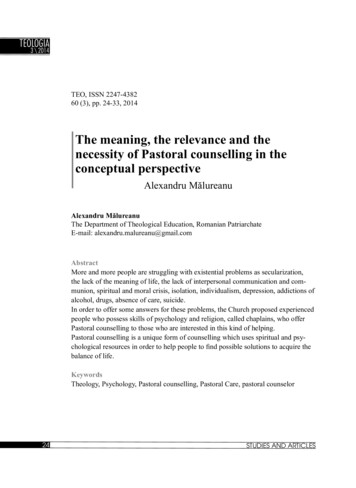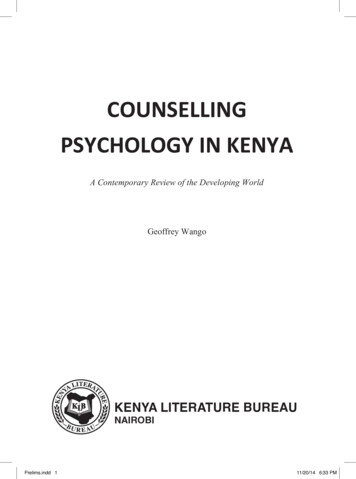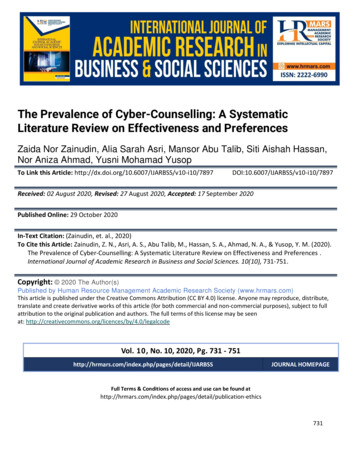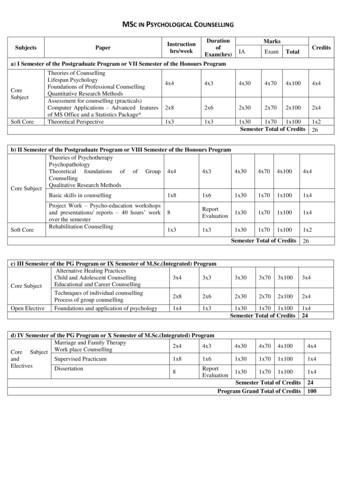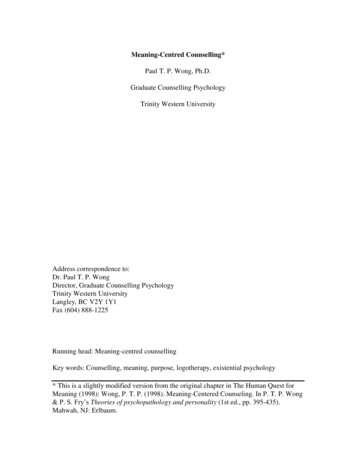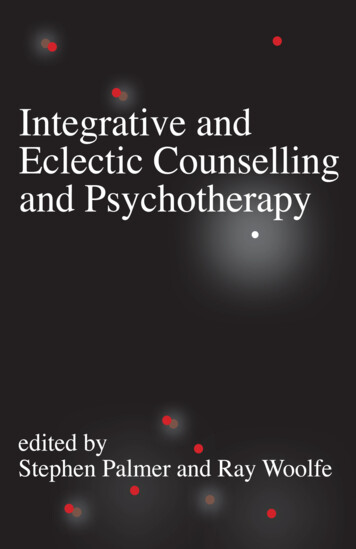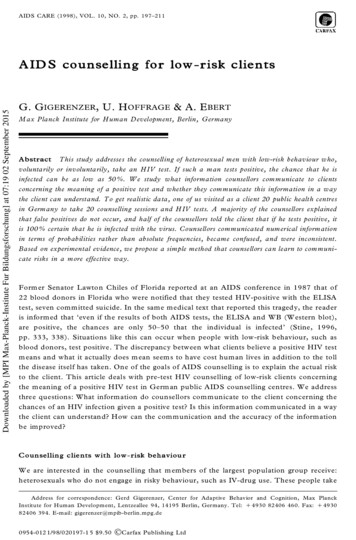
Transcription
A ID S CAR E (1998), VOL . 10, NO. 2, pp. 197 211Downloaded by [MPI Max-Planck-Institute Fur Bildungsforschung] at 07:19 02 September 2015AID S counselling for low -risk clientsG. G IGER ENZER , U. H OFFRAGE & A. E BERTM ax Planck Institute for Human D evelopment, Berlin, GermanyA bstract This study addresse s the counselling of heterosexual m en with low-risk behaviour w ho,voluntarily or involuntarily, take an HIV test. If such a m an tests positive, the chance that he isinfected can be as low as 50%. W e study what information counsellors com municate to clientsconcerning the meaning of a positive test and whether they com municate this information in a w aythe client can understand. T o get realistic data, one of us visited as a client 20 public health centresin Germ any to take 20 counselling sessions and H IV tests. A majority of the counsellors explainedthat false positives do not occur, and half of the counsellors told the client that if he tests positive, itis 100% certain that he is infected with the virus. Counsellors communicated num erical inform ationin terms of probabilities rather than absolute frequencies, became confused, and were inconsistent.Based on experimental evidence, we propose a simple method that counse llors can learn to com municate risks in a m ore effective way.Form er Senator Lawto n C hiles of Florida reported at an AIDS conference in 1987 th at of22 blood donors in Florida who were notified that they tested H IV-po sitive with the ELISAtest, seven com m itted suicide. In the sam e m edical text that reported this traged y, the readeris inform ed that even if th e results of both AIDS tests, the ELISA and W B (W estern blot),are positive, the chances are only 50 50 that the individual is infected’ (Stine, 1996,pp. 333, 338). Situations like this can occur when people with low-risk behaviour, such asblood donors, test positive. The discrepancy betw een what clients believe a positive HIV testm eans and what it actually does m ean seem s to have cost hum an lives in addition to the tollthe disease itself has taken. O ne of the goals of AIDS counselling is to explain the actual riskto the client. This article deals with pre-test H IV counselling of low-risk clients concerningthe m eaning of a positive H IV test in G erm an public A ID S counselling centres. W e addressthree questions: W hat inform ation do counsellors com m unicate to the client concerning th echances of an HIV infection given a positive test? Is this inform ation com m unicated in a waythe client can understan d? H ow can the com m unication and the accuracy of the inform ationbe improved?C ounselling clients with low-risk behaviou rW e are interested in the counselling that m embers of the largest pop ulation group receive:heterosexuals who do not engage in risky behaviour, such as IV-drug use. These people tak eAddress for correspondence: Gerd Gigerenzer, Center for Adaptive Behavior and Cognition, Max PlanckInstitute for H uman Development, Lentzeallee 94, 14195 Berlin, Germany. Tel: 1 4930 82406 460. Fax: 1 493082406 394. E-mail: gigerenzer@mpib-berlin .mpg.de0954-012 1/98/020197-1 5 9.50ÓCarfax Publishing Ltd
Downloaded by [MPI Max-Planck-Institute Fur Bildungsforschung] at 07:19 02 September 2015198G . GIG EREN ZER E T AL .H IV tests for various reasons: voluntarily, because they wan t to find out whether th ey areinfected before getting m arried, having children, or for other reasons; or involuntarily,because they are imm igrants, ap plicants for health or life insurance, m ilitary personnel, blooddonors, or m em bers of other groups that are required by law to take the test. The Swedishgovernm ent, for instance, has encouraged voluntary testing to the point that people who areunlikely to be infected are the ones who take the test, in droves’ (M aÊ nsson, 1990).Involuntary testing is a legal possibility in several countries, which insurers exploit to protectthem selves against losses. For instan ce, in 1990, Bill C linton (then G overnor of Arkansas)had to take an H IV test to get his life insurance renewed (D er Tagesspiegel, 16 Sept/96, p. 4).People with low-risk behaviour m ay be subjected to H IV tests not only involuntarily but alsounknowingly. For instance, large com panies in Bom bay have reportedly subjected theirem ployees to blood tests without telling them that they were being tested for AIDS; when atest was positive, the employee was fired (D er T agesspiegel, 8 July/96).C ounselling people at low risk requires paying particular atten tion to false positives, thatis, to the possibility that the client has a positive H IV test even tho ugh he or she is notinfected with the virus. The lower th e prevalence of HIV in a group, the larger th e proportionof false positives am ong those who test positive. In other words, if a client with high-riskbehaviour tests positive, the probability that he actually is infected with HIV is very high, butif som eone with low-risk behaviour tests positive, th is probability m ay be as low as 50%, asindicated above. If clients are not informed abo ut this fact, they tend to believe that a positivetest m eans that they are infected with abso lute certainty. The case of a young m an fromD allas that circulated in the U S press is one exam ple. This m an tested positive on a routineH IV test, becam e depressed and contem plated suicide, and m oved to C alifornia. A fter som e18 m onth s of anguish, a C alifornian doctor m ade him take the test again, and it cam e backnegative (Chicago Tribune, 5 M arch/93). If the young m an had com m itted suicide, as th eblood donors in the Florida case did, we m ight never have found out that his test was a falsepositive. Em otional pain and lives can be saved if counsellors inform the clients abou t th epossibility of false positives.1W e do not know of any study that has investigated what AIDS counsellors tell theirclients abo ut the m eaning of a positive test. W e pondered long over the proper m ethodology,such as sending questionnaires to counsellors or asking them to participate in paper-andpencil tests. H ow ever, we decided against questionnaires and similar m ethod s because theyare open to the criticism that they tell us little abou t actual counselling sessions. For instance,these m ethods have been criticized for not allowing physicians to pose their ow n questions toget further inform ation, to use their own estimates of the relevant statistical inform ationrather than those provided by th e experim enter, and for rem oving th e element of actualconcern for the patient, because either the patient is fictional or the case was resolved yearsago (Phelps & Shan teau, 1978; Y ates, 1990).In the end, we decided to take a direct route. O ne of us went as a client to 20 counsellingsites and took a series of counselling sessions and H IV tests. W e were interested in oneimportant issue that A ID S counsellors have to explain to th e client: W hat does a positive testresult m ean? To answ er this question, one needs to know : (a) the base rate of HIV inheterosexual m en with low risk, which is referred to as the prevalence, (b) th e probability thatthe test is positive if the client is infected, which is referred to as the sensitivity (or hit rate)of th e test, and (c) the probability that th e test is positive if the client is not infected, whichis known as the false positive rate (or 1 2 specificity). From this information, one can estim atewhat a positive test actually m eans, that is, the prob ab ility of being infected if one testspositive, also know n as the positive predictive value (PPV). Let us first get the best estimatesfor these values from the literature.
A ID S C O UN SELLIN G F O R LO W -RIS K C LIEN T S199Downloaded by [MPI Max-Planck-Institute Fur Bildungsforschung] at 07:19 02 September 2015PrevalenceG erm any has a relatively sm all num ber of reported AIDS cases. The cum ulative num ber bythe end of 1995 was 13,665, as com pared to som e 30,000 in Italy, 38,000 in France, andm ore than 500,000 in the U SA (W HO , 1996). Thus one can assum e that the prevalence ofH IV is also com paratively low. The client in our study was 27 years old, a G erm anheterosexual m ale who did not engage in risky behaviour. W hat is the prevalence of the HIVvirus in 20- to 30-year-old heterosexual m en in Germ any who do not engage in riskybehaviour? A reasonab le estimate is abo ut one in 10,000, or 0.01% .2 This figure is in th erange of th e prevalence of HIV in blood donors in the U SA (a group with low prevalencewithin the U SA), which has been estim ated at one in 10,000 (Busch, 1994, p. 229) or tw oin 10,000 (George & Schochetm an, 1994, p. 90).Sensitivity and specificityIn G ermany, as in m ost W estern countries, H IV testing typically involves the followingsequence. If th e first test, EL ISA, is negative, the client is notified that he or she isH IV-negative. If positive, at least one m ore EL ISA (preferably from a different m anufacturer)is conducted. If the result is again positive, then the m ore expensive and tim e-consum ingW estern blot test is perform ed. If the W estern blot is also positive, then the client is notifiedof being HIV-po sitive, and som etimes a second blood sam ple is also tested. Thus, two errorscan occur. First, a client who is infected is notified that he is HIV-negative. The probabilityof this error (false negative) is the com plement of the sensitivity of th e ELISA test. Theestim ates for the sensitivity typically range betw een 98% and 99.8% (Eberle et al., 1988;G eorge & Schochetm an, 1994; Schw artz et al., 1990; Sp ielberg et al., 1989; Tu et al., 1992;W ilber, 1991). Second, a client who is not infected is notified of being HIV-po sitive. Theprobability of this second error (false positive) is the complem ent of the com bined specificityof th e ELISA and W estern blot tests. Although all surveys agree that false positives do occur,the quantitative estim ates vary widely. 3 This is in part due to the fact th at what constitutesa positive W estern blot test has not been stan dardized (various agencies use differentreagents, testing m ethod s, and test-interpretation criteria (Stine, 1996, p. 335)), that th eELISAs and the W estern blot tests are not independent (that is, one cannot simply m ultiplythe individual false positive rates of the tests to calculate the com bined false positive rate,Spielberg et al., 1989), and that the higher the prevalence in a group, the lower the specificityseems to be for this group (W ittkow ski, 1989). For instan ce, 20 sam plesÐ half with HIVantibodies and half witho ut (the laboratories were not inform ed which sam ples werewhich)Ð were sent in 1990 to each of 103 laboratories in six W HO regions (Snell et al.,1992). About 70 different com binations of tests were applied. O f the sam ples withoutH IV antibodies, 1.3% were incorrectly classified as positive. A combined specificity of only98.7% , as in this blind proficiency testing, how ever, is an unusually low estim ate. M ostof the estimates in the literature are considerably higher, usually higher th an 99.9% (Burkeet al., 1988; Eberle et al., 1988; Peichl-Hoffm an, 1991; Tu et al., 1992). For instance,the G erm an R ed C ross achieved for first-tim e blood donors a com bined specificity of99.98% (W ittkow ski, 1989). From the figures published, a reasonable estim ate for th ecom bined specificity seems to be abou t 99.99% . That is, the false positive rate is abo ut onein 10,000. This is an estim ate, and m ore accurate num bers m ay be available from futureresearch.
200G . GIG EREN ZER E T AL .Positive predictive valueW hat the client needs to understan d is th e probability of being infected with H IV if he testspositive. The predictive value of a positive test (PPV) can be calculated from the prevalencep(H IV), the sensitivity p(pos u H IV), and the false positive rate p(pos u no HIV):Downloaded by [MPI Max-Planck-Institute Fur Bildungsforschung] at 07:19 02 September 2015PPV 5p(H IV)p(pos u H IV)p(H IV)p(pos u HIV) 1p(no H IV)p(pos u no H IV),(1)where p(no H IV) equals 1 2 p(HIV). Equation 1 is know n as Bayes’ s rule. This rule expressesthe importan t fact that the sm aller the prevalence, the sm aller the probability that a client isinfected if the test is positive. W hat is th e predictive value of a positive test for a 20- to30-year-old heterosexual G erman m an wh o does not engage in risky behaviour? Inserting th eprevious estimatesÐ a prevalence of 0.01% , a sensitivity of 99.8% , and a specificity of99.99% (repeated ELISA and W estern blot)Ð into B ayes’ s rule, the PPV results in 0.50, or50% .A n estim ated PPV of abo ut 50% for heterosexual m en who do not engage in riskybehaviour is consistent with the report of the Enquete Com m ittee of the G erman Bundestag,which estim ated the PPV for low-risk people as less than 50%’ (Deutscher B undestag, 1990,p. 121).H ow to com municate the positive predictive value. Even if a counsellor understan ds thisform ula, ordinary people rarely do (Gigerenzer & H offrage, 1995). M oreover, we know frompap er-and-pencil studies in the U SA and in G ermany that even exp erienced physicians havegreat difficulties when asked to infer the PPV from prob ab ility inform ation (Casscells et al.,1978; Daw es, 1988; Eddy, 1982; H offrage & G igerenzer, 1996; W indeler & K oÈ bb erling,1986). But we also know from a recent study with 48 physicians in M unich that physicians’performance can be substantially improved, by a factor of m ore th an four, if the inform ationis presented in natural frequencies rather th an in term s of prob ab ilities or percentages(Gigerenzer, 1996; Hoffrage & Gigerenzer, 1998). By natural frequencies we m ean inform ation represented in term s of absolute (not relative) frequencies, th at is, in the way aphysician would have actually experienced the frequencies if sh e had sam pled the individualcases herself (Gigerenzer & H offrage, 1995). M ore precisely, natural frequencies are frequencies which have not been norm alized with respect to the base rate (prevalence) of the disease.N orm alized frequencies, such as prob ab ilities and percentage s, have only em erged in th elast few centuries as tools to represent degrees of uncertainty (Gigerenzer et al., 1989),whereas throu gh m ost of hum an history and evolution, m inds had to deal only with natu ralfrequencies.H ow wo uld a counsellor com m unicate inform ation in natural frequencies? She m ightexplain to the patient the m eaning of a positive test in the following way: Im agine 10,000heterosexual m en like you being tested. O ne has the virus and he will with practical certaintytest positive. O f the rem aining non-infected m en, one will also test positive (the false positiverate of 0.01%). Thus we expect th at tw o m en will test positive, and only one of them hasH IV. This is th e situation you are in if you test positive; the chance of having the virus is oneout of tw o, or 50% .’This simple m ethod can be app lied whate ver th e relevant num bers are assum ed to be.If the prevalence is tw o in 10,000, the PPV would be tw o out of three, or 67% . The num berscan be adjusted; the point is that clients can understand m ore easily if the counsellorcom m unicates in natural frequencies than in prob ab ilities. W ith a frequency representationthe client can see’ how th e PPV depends on th e prevalence. If the prevalence of HIV am ong
A ID S C O UN SELLIN G F O R LO W -RIS K C LIEN T S201Downloaded by [MPI Max-Planck-Institute Fur Bildungsforschung] at 07:19 02 September 2015G erm an hom osexuals is abou t 1.5% , then the counsellor m ight exp lain: T hink of 10,000hom osexual m en like you. About 150 have the virus and they all will likely test positive. O fthe rem aining non-infected m en, one will also test positive. Thus, we expect that 151 m enwill test positive, and 150 of them have HIV. This is the situation you are in if you testpositive; the chance of having the virus is 150 out of 151, or 99.3% .’In general, the PPV is the num ber of true positives (TP) divided by the num ber of truepositives and false positives (FP):PPV 5TPTP 1FP(2)The com parison betw een equations (1) and (2) sho ws that natu ral frequencies m akem ental com putations easier. Frequencies are fairly accurately and almost autom aticallym onitored in hum ans and animals (e.g. C osm ides & Tooby, 1996; Jonides & Jones, 1992).From this research it follows that physicians and lay people alike can understan d risks betterwhen the inform ation is com m unicated in natu ral frequencies rather than in probabilities orpercentage s.Public HIV counsellingSom e 300 Germ an public health centres ( G esundheitsaÈ m ter’ ) offer free HIV tests and A ID Scounselling for th e general public. By 1990, these centres had hired 315 counsellors, 43% ofwhom were physicians, 22% social wo rkers and 7% psych ologists. The rest had variousprofessional training (Fischer, 1990). As in other countries, counselling before testing isdesigned to m ake sure that the client understan ds the testing procedure, the risks for HIVinfection, and the m eaning of either a positive or negative test (W ard, 1994). The report ofthe Enquete Com m ittee of the G erm an Bundestag (D uetscher Bundestag, 1990, p. 122)directs the counsellor explicitly to perform a qu antitative and qualitative assessm ent of th eindividual risk’ and to explain the reliability of the test result’ before a test is taken. If th eclient decides to take a test, anonym ity is guaranteed in all G erm an state s (unlike in the U SA,where in 25 states the patient’ s nam e is reported, Stine, 1996, p. 346). C ounselling requiresboth social tact and know ledge abou t the uncertainties involved in testing, and the fact thatin 1990 abo ut 37% of clients tested at publicly funded clinics in the U SA failed to return fortheir test results suggests that counselling is not always successful (D oll & K ennedy, 1994).W hat inform ation concerning th e m eaning of a positive test do counsellors in G erm anpublic health centres give a client with low-risk behaviour? H ow is this inform ation com m unicated (e.g. in probabilities or in natural frequencies)?M ethodsCounselling centresThe client’ visited 20 public AIDS counselling centres in 20 G erman cities, including largecities such as Berlin, H am burg and M unich. Two additional counselling centres were visitedin a pilot study that was conducted to design the details of the interview. The 20 counsellingcentres were distributed over nine G erman state s in form er W est G ermany. O f the 20counsellors, 14 were physicians and six social workers; 12 were fem ale and eight m ale.The client first contacted the health centres by telephone and m ade an appointm ent. Hecould visit tw o centres in sh ort sequence, followed by a break of at least tw o weeks to allow
Downloaded by [MPI Max-Planck-Institute Fur Bildungsforschung] at 07:19 02 September 2015202G . GIG EREN ZER E T AL .the hem atom as from the perforation of the veins in his arm s to heal. These breaks werenecessary, otherwise signs in the arm m ight have suggested to the counsellor that th e clientwas a drug addict.Investigating AIDS counsellors’ perform ance without their knowledge raises ethicalproblem s. W e consulted the Ethics Com m ittee of the G erman Association of Psychology,which inform ed us that in the present case the expected utility of the results of the studycould justify deceiving of th e counsellors. Public counselling is pub lic behaviour; nevertheless, in deference to th e Ethics C om m ittee’ s interpretation of G erm an privacy laws, wedecided not to tape the sessions. M oreover, we protect the anonym ity of th e counsellors. W eapo logize to all of the counsellors for having used this covert m etho d, but believe that th eresults of this study justify the approach by revealing what can be im proved in future A ID Scounselling.T he interviewThe client asked the counsellor the following questions in the order indicated (unless th ecounsellor provided the information unprom pted):(1) Sensitivity of the HIV test. If one is infected with HIV, is it possible to have a negativetest result? How reliably does the test identify a virus if the virus is present?(2) Specificity of the H IV test. If one is not infected with HIV, is it possible to have apositive test result? H ow reliable is the test with respect to a false positive result?(3) Prevalence of H IV in heterosexual men. H ow frequent is the virus in m y risk group,that is, heterosexual m en, 20 to 30 years old, with no know n risk such as drug use?(4) Predictive value of a positive test. W hat is the probability that m en in m y risk groupactually do have H IV after a positive test?(5) W indow period. How m uch tim e has to pass between infection and test, so thatantibodies can be detected?The pilot study indicated a tendency in counsellors to provide vagu e and noninform ative answ ers, such as, D on’ t worry; the test is very reliable; trust m e’ . It alsoindicated that if the client ask ed for clarification m ore than twice, the counsellors were likelyto becom e upset and angry, exp eriencing the client’ s insistence on clarification as a violationof social norm s of com m unication. Based on th ese pilot sessions, th e interview included th efollowing schem e for clarifying questions: If the counsellor’ s answ er was a quantitativeestim ate (a num ber or a range) or if the counsellor said th at he or she could not (or did notwant to) give a m ore precise answer, then the client went on to the next question. If th eansw er was qualitative (e.g. fairly certain’ ) or if the counsellor m isunderstood or avo idedansw ering th e question, then the client asked for further clarification and, if necessary,repeated this request for clarification one m ore tim e. If, after the third atte m pt, th ere was stillno success, the client did not push further and went on to the next question. W hen the clientneeded to ask for clarification concerning the prevalence of H IV (Question 3), he alwaysrepeated his specific risk group; when asking for clarification concerning the PPV (Question4), he always referred to th e specific prevalence in his risk group.A s m entioned above, wh en the client asked for the prevalence of HIV in his risk group,he specified th is group as heterosexual m en, 20 to 30 years old, with no known risk such asdrug use’ . W hen counsellors asked for m ore information, which happen ed in only 11 of th esessions, the client exp lained that he was 27 years old, m onogam ous, and that neither hiscurrent nor his (few) previous sexual partners used drugs or engage d in risky behaviour. Intwo of th ese 11 cases, the client was given a detailed questionnaire to determ ine his risk; in
A ID S C O UN SELLIN G F O R LO W -RIS K C LIEN T S203Table 1. Informatio n provided by the counsellorsDownloaded by [MPI Max-Planck-Institute Fur Bildungsforschung] at 07:19 02 September 2015100% certainty 99.9% 99% 90%R angeSensitivity5 (of 19)56390 100%Speci cityPrevalencePPV13 (of 19)Ð10 (of 18)33099.7 100%0.0075 6%90 100%ÐÐ5Ð12N ote: Not all counsellors provided numerical estimates. The verbal assertion absolutely certain’is treated here as equivalent to 100% certain; verbal assertions such as almost absolutely certain’and very, very certain’ are classi ed as 99%, and assertions such as very reliable’ are classi edas 90%.one of th ese cases the counsellor did not look at th e questionnaire and the client still had itin his han ds wh en he left the site.The client was trained in simulated sessions to use a coding system (question num ber;num ber of repetitions of a question; the counsellor’ s answ er at each repetition; e.g. ª 1; 2;99.9% º ) that allowed him to write dow n the relevant information in sho rth and during th ecounselling, or, if the session was very brief, to rehearse the code in m emory and write itdow n imm ediately after the counselling session.A fter the counselling session, the client took the HIV test, except for three cases (in tw ohe would have had to wait several hours to take the test, and in one case th e counsellorsugge sted that the client m ight first consider it over night before m aking the decision ofwhether or not to take the test).R esultsFour counselling sessions are sho wn, for illustration, in the A ppendix. The client’ s questionsare abbreviated (e.g. sensitivity?), and th e inform ation provided by th e counsellor directlyfollows the question. The counsellors’ answ ers to the client’ s clarifying questions are preceded by a hyphen in subsequent lines.Sensitivity and window periodN ineteen of 20 counsellors gave the client inform ation concerning sensitivity. (The twentiethrefused to give any inform ation concerning sensitivity, sp ecificity, and the predictive valuebefore the test result was obtained. W hen the client picked up th e test result, he got noinform ation either.) M ost counsellors gave the client realistic inform ation concerning th esensitivity (Table 1). H ow ever, five of the 19 counsellors incorrectly inform ed the client thatit would be impossible to get a false negative result, except during the window period. Fifteencounsellors provided inform ation concerning the window period when asked for th e sensitivity. The m edian estimate for the window period was 12 weeks.False positivesThirteen of 19 counsellors inform ed the client incorrectly that false positives do not occur(e.g. Session 1). Eleven of these explained that the reason is that repeated testing with ELISAand W estern blot eliminates all false positives. Five of th ese 13 counsellors told the client thatfalse positives had occurred in the 1980s, but no longer today, and tw o said that falsepositives wo uld occur only in foreign countries, such as France, but not in G ermany. In
204G . GIG EREN ZER E T AL .Downloaded by [MPI Max-Planck-Institute Fur Bildungsforschung] at 07:19 02 September 2015addition to these 13 counsellors, three other counsellors first sugge sted that false positiveswould not occur, but becam e less certain when the client repeated his question, and adm ittedthe possibility of false positives (Sessions 2 and 3). O nly the three rem aining counsellorsinform ed the client right away abou t th e existence of false positives. O ne of them (Session 4)was the only counsellor who inform ed the client abo ut the im portant fact that the proportionof false positives to true positives is particularly high in heterosexuals such as th e client.PrevalenceThe question concerning the prevalence of H IV in heterosexual m en with low-risk behaviourproduced the m ost uncertainty am ong th e counsellors. Sixteen of 20 (all counsellorsrespo nded) expressed uncertainty or ignorance, or argued that the prevalence for heterosexual m en with low-risk behaviour cannot be determ ined (e.g. because of unreported cases),or that it wo uld be of no use for the individual case (e.g. Session 2). Several counsellorssearched for publications in respo nse to the client’ s question but found only irrelevantstatistics, such as the large num ber of HIV positives in W est Berlin: T he W all was the bestcondom for East Berlin’ , one counsellor answ ered. Twelve counsellors provided num ericalestim ates, with a m edian of 0.1% . The variability of the estimates was considerable (Table1), including th e extrem e estimate that in people such as the client an H IV infection is, lessprobable than winning the lottery th ree tim es’ (we have not included this value in Table 1).Four counsellors asserted that information concerning prevalence is of little or no use: Butstatistics don’ t help us in the individual caseÐ and we also have no precise data’ (see alsoSessions 2 and 3). Tw o counsellors said that th ey have problems remem bering num bers orreasoning with num bers, for instance: I have difficulties reasoning with statistical inform ation. It’ s abo ut groups and the transfer is problem atic. It rem inds m e of playing th elottery. The probability of getting all six correct is very sm all; nevertheless, every weeksom eone wins.’Positive predictive valueR ecall that under the currently available estim ates, only som e 50% of heterosexual G erm anm en with low-risk behaviour actually have HIV if they test positive. The inform ationprovided by the counsellors was quite different. Half of the counsellors (ten of 18; tw orepeatedly ignored th is question) told the client that if he tested positive it was ab solutelycertain (100% ) th at he has HIV (Table 1 and Session 1). Five told him that the probabilityis 99.9% or higher (e.g. Session 3). Thus, if the client had tested positive and trusted th einform ation provided by these 15 counsellors, he m ight indeed have contem plated suicide, asm any have before (Stine, 1996).H ow did th e counsellors arrive at this inflated estim ate of the predictive value? Theyseemed to have tw o lines of thou ght. A total of eight counsellors confused the sensitivity withthe PPV (a confusion also reported by Eddy, 1982, and Elstein, 1988), that is, they gave th esam e num ber for the sensitivity and the PPV (e.g. Sessions 2 and 3). Three of these eightcounsellors explained that except for the window period, the sensitivity is 100% and thereforethe PPV was also 100%. A nother five counsellors reasoned by the second strategy. They(erroneously) assum ed that false positives would be eliminated throu gh repeated testing andconcluded from this (consistently) that the PPV is 100% . For both groups, the client’ squestion concerning the PPV m ust have appe ared as one they had already answ ered. In fact,m ore than half of the counsellors (11 of 18) explicitly introduced th eir answ ers with a phrasesuch as, A s I have already said ¼ ’ (e.g. Sessions 1 3). C onsistent with this observation, th e
Downloaded by [MPI Max-Planck-Institute Fur Bildungsfo
the client can understand. To get realistic data, one of us visited as a client 20 public health centres in Germany to take 20 counselling sessions and HIV tests. A majority of the counsellors explained that false positives do not occur, and half of the counsellors told the client that if he tests positive, it

